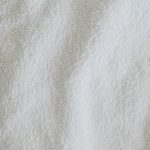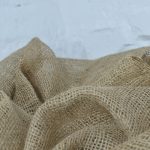When I touch linen, I feel for its unique rough texture and lightweight quality, showing it's made from natural flax fibers. The distinctive slubby appearance also gives it away. If you're curious to know more ways to identify linen, there are characteristics like its plain weave pattern and special care labels that can help you distinguish it from other fabrics. Keep exploring to learn about the fascinating linen production process and the different types of linen fabrics available.
Table of Contents
Key Takeaways
- Natural flax fibers have a distinctive texture and appearance.
- Linen is lightweight with a slightly coarse texture and tendency to wrinkle.
- Linen typically has a plain weave pattern.
- Check labels for material composition and care instructions.
- Burn test reveals linen's unique burning characteristics and odor.
Natural Flax Fibers
When examining linen fabric, one can easily spot the unique and irregular natural flax fibers that give it its distinctive texture and appearance. Flax, the plant from which linen is derived, produces fibers that are thick and have a slightly coarse texture. These flax fibers are what make linen stand out among other fabrics. The irregularity of flax fibers gives linen its characteristic look, with a slightly slubby appearance that adds to its charm.
One can observe the natural flax fibers in linen by looking closely at the fabric. These fibers are thicker compared to other materials, and their unique appearance sets linen apart. The presence of flax fibers not only contributes to the texture of linen but also plays a significant role in its overall aesthetic appeal. It's fascinating to see how these natural fibers come together to create a fabric that isn't only durable but also exudes a sense of elegance.
Weight and Texture Examination
Examining the weight and texture of linen fabric reveals key characteristics that distinguish it from other materials.
Linen is noticeably lightweight, making it stand out from heavier fabrics like polyester or wool. When I touch linen, its rough and natural texture is unmistakable, providing a tactile indicator for identification. This roughness is a defining feature of linen, setting it apart from smoother materials.
Additionally, linen's tendency to wrinkle easily contributes to its distinctive appearance. Despite its propensity to crease, linen also has the unique ability to smooth out, giving it a natural and effortless look. The casual and relaxed aesthetic of linen further aids in its differentiation from more formal fabrics.
Fabric Weave Analysis
Feeling the rough and natural texture of linen fabric provides a distinct tactile experience that can be further understood through fabric weave analysis. Linen fabric is typically woven in a plain weave pattern, where fibers cross over and under each other in a simple and consistent manner. This plain weave structure gives linen its characteristic appearance and texture, making it easily distinguishable from other fabrics.
Label and Care Instructions Check
Upon reviewing fabric labels and care instructions, one can easily identify linen by checking for specific material compositions and care requirements. When examining the labels, look for any mention of linen in the fabric composition or care instructions. Manufacturers often label linen fabric explicitly, making it easier for consumers to recognize. Additionally, special care requirements such as hand washing or air drying can be indicative of linen due to its delicate nature.
- Material Composition: Check for any indication of linen in the fabric composition listed on the label.
- Explicit Labeling: Manufacturers may specify if the fabric is linen in the care instructions on the label.
- Special Care Requirements: Look for care instructions that suggest gentle handling, as linen often requires delicate care to maintain its quality and longevity.
Burn Test Procedure
When performing a burn test on fabric, it's vital to pay attention to the burning characteristics and the smell produced.
Linen typically burns with a steady flame and gives off an odor akin to burning paper or leaves. Understanding these points can help distinguish linen from synthetic materials with their different burning behaviors.
Fabric Burning Characteristics
To determine if a fabric is linen, one can conduct a burn test in an inconspicuous corner to observe the burning characteristics.
When linen fabric is burned, it produces a steady flame and leaves behind fine ash, distinguishing it from synthetic fibers that melt and drip.
Additionally, the smell of burning linen is similar to burning paper or leaves.
This distinct burning behavior is due to linen being derived from the flax plant, giving it unique characteristics that can be identified through a simple burn test.
Conducting this test helps differentiate linen from synthetic fabrics, making it a useful method for identifying authentic linen materials.
Odor Produced During Burning
During a burn test to identify linen, the essential odor produced can be likened to the scent of burning paper or leaves. This distinct smell, reminiscent of burning paper, serves as a pivotal indicator of linen fabric during a burn test.
Unlike synthetic fibers that melt and emit different odors when burned, linen maintains its unique scent. Recognizing this specific odor during a burn test is a reliable method to differentiate linen from synthetic fabrics.
Characteristics of Linen Fabric
Linen fabric stands out due to its absorbent, hypoallergenic, and antibacterial properties, making it a preferred choice for those with sensitive skin. When examining linen, its distinctive characteristics become apparent:
- Unique Texture and Luster: The irregular fibers of the flax give linen a one-of-a-kind texture and natural shine that differentiates it from other fabrics.
- Natural Imperfections: Linen's natural luster and grain pattern, along with imperfections like slubs and bumps, enhance its appeal and charm.
- Color and Durability: Look for natural hues such as pale yellowish-gray, beige, or taupe to identify linen fabric. Additionally, linen boasts low elasticity, wrinkles gracefully, and is highly durable, showcasing resistance to wear and tear.
Understanding these key characteristics can help you confidently recognize and appreciate the quality of linen fabric, making it a valuable addition to your wardrobe or home textiles.
Types of Linen Fabrics
Let's talk about the different types of linen fabrics.
From the luxurious Damask linen, perfect for high-end decorative pieces, to the lightweight and breathable loosely-woven linen ideal for warm climates.
Plain-woven linen offers a simple yet durable option, suitable for everything from towels to versatile fashion items.
Understanding these various types can help you choose the right linen fabric for your needs.
Linen Fabric Characteristics
In warm climates, loosely-woven linen stands out for its lightweight and soft texture, making it a preferred choice for various applications. When it comes to linen fabrics, there are several types each with unique characteristics:
- Damask linen: Luxurious fabric with a reversible pattern, originating from Damascus.
- Loosely-woven linen: Lightweight and soft, ideal for warm climates.
- Plain-woven linen: Simple weave pattern, suitable for towels and napkins.
These different types of linen offer versatility in uses ranging from high-end decorative items to everyday essentials like towels and napkins. Understanding the characteristics of each type can help in selecting the right linen fabric for specific needs.
Linen Fabric Care
Proper care of these various types of linen fabrics guarantees they maintain their quality and longevity for repeated use.
When dealing with linen fabrics, it's crucial to bear in mind that they can have a rough texture compared to other materials.
Damask linen, recognized for its luxurious reversible pattern, requires delicate handling to preserve its intricate design.
Loosely-woven linen, favored for its lightweight and soft feel, benefits from gentle washing to prevent damage to the delicate weave.
Plain-woven linen, with its simple weave pattern, is versatile but may need extra care due to its rough texture.
Linen Textile Production Process
Cultivating flax plants is the essential step in the linen textile production process. Flax plants are specifically grown for their fibers, which are used to make linen.
The process of turning flax into linen involves several key steps:
- Retting: Flax stalks are soaked in water to help break down the pectins that bind the fibers to the stalks.
- Breaking and scutching: After retting, the flax stalks are beaten to separate the fibers from the woody core.
- Hackling: The fibers are combed through to remove impurities and align them in a parallel form, making them suitable for spinning.
These initial stages are vital in preparing the raw material for the subsequent spinning and weaving processes that ultimately result in the creation of high-quality linen fabric.
Frequently Asked Questions
How Can You Tell if Something Is Linen?
To tell if something is linen, I look for natural colors like pale yellowish-gray or beige, check for wrinkles and low elasticity, test absorbency, and notice the rough texture that smoothes over time.
How Is Linen Identified?
I identify linen by looking for natural colors like pale yellowish-gray or beige, checking for wrinkles and low elasticity, examining durability, testing absorbency, and noticing slubs and a rough texture.
What Are 5 Characteristics of Linen?
Linen boasts a natural luster, high absorbency, durability, smooth texture, and softness that improve with each wash. These characteristics make it perfect for warm weather wear and bedding. Its unique charm sets it apart.
How Can You Tell the Difference Between Linen and Fabric?
To tell the difference between linen and fabric, I observe the absorption rate. Linen absorbs water quickly, distinguishing it from other materials. Its cool, smooth texture and refinement with use are key indicators of authentic linen.
- The Use of Nonwovens in Construction and Civil Engineering - July 11, 2025
- The Use of Nonwovens in Construction and Civil Engineering - July 11, 2025
- The Use of Nonwovens in Construction and Civil Engineering - July 11, 2025




